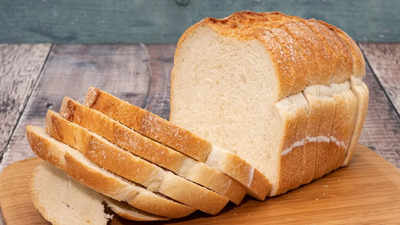Trending
The REAL reason why bread should not be stored in a fridge
Refrigerating bread accelerates staling due to starch retrogradation, impacting texture. Refrigeration leads to faster onset of staleness, tough texture, and absorption of odors, affecting flavor negatively.

Bread is a staple in many households, cherished for its versatility and comfort. However, the way we store bread can significantly affect its quality and longevity. A common misconception is that refrigerating bread extends its freshness. In reality, storing bread in the fridge can have the opposite effect, leading to faster staling and a loss of its delightful texture and flavour.Here’s a closer look at why bread should not be stored in the fridge.
The science behind bread staling
To understand why refrigeration is detrimental to bread, we need to delve into the science of staling. Staling is a process that involves the retrogradation of starch molecules. When bread is baked, starch granules absorb water and gelatinize, contributing to the soft and fluffy texture of fresh bread. However, once the bread cools, the starch molecules begin to recrystallize, expelling water and leading to a firm and dry texture.
The role of temperature
Texture and flavour impact
Refrigerating bread not only accelerates staling but also negatively impacts its texture and flavour. Bread stored in the fridge often becomes tough and chewy, losing its initial softness. The moisture expelled from the starch molecules does not evaporate but instead accumulates on the bread's surface, making it feel dry and unappealing.
In terms of flavour, the refrigeration process can cause bread to absorb odors from other foods stored in the fridge. This can lead to an undesirable taste, making even fresh bread seem stale and off-flavoured.

Mould prevention: A common misconception
Many people refrigerate bread to prevent mould growth, believing that cooler temperatures inhibit mold spores. While it is true that refrigeration slows down mold growth, the benefit is marginal when weighed against the accelerated staling process. For short-term storage, keeping bread at room temperature in a dry, airtight container is usually sufficient to prevent mold. For longer-term storage, freezing bread is a much better option. Freezing halts both mould growth and staling, preserving the bread’s freshness effectively.
Optimal storage solutions
To keep bread fresh and enjoyable for longer, consider the following storage tips...
Room Temperature: Store bread at room temperature in a cool, dry place, ideally in a bread box or a paper bag. This helps maintain its moisture balance and delays staling.
Freezing: For longer storage, slice the bread and place it in an airtight plastic bag before freezing. Sliced bread can be easily thawed or toasted, preserving its texture and flavour.
Avoid Plastic Bags at Room Temperature: While plastic bags can prevent moisture loss, they can also create a humid environment that promotes mold growth. If using plastic, ensure the bread is consumed quickly.
Storing bread in the fridge is a common practice rooted in the desire to prolong freshness. However, the science of starch retrogradation reveals that refrigeration accelerates staling, leading to a loss of texture and flavour. By understanding the real impact of refrigeration on bread, we can make better storage choices that preserve its quality. Opting for room temperature storage or freezing can help keep your bread delicious and fresh for longer.
The science behind bread staling
To understand why refrigeration is detrimental to bread, we need to delve into the science of staling. Staling is a process that involves the retrogradation of starch molecules. When bread is baked, starch granules absorb water and gelatinize, contributing to the soft and fluffy texture of fresh bread. However, once the bread cools, the starch molecules begin to recrystallize, expelling water and leading to a firm and dry texture.
The role of temperature
Temperature plays a crucial role in the rate of starch retrogradation. Research shows that the process accelerates at temperatures just above freezing, typically between 32°F and 50°F (0°C and 10°C). This range, unfortunately, coincides with the typical temperature of a refrigerator. Thus, when bread is stored in the fridge, the starch recrystallizes much faster, leading to a quicker onset of staling compared to storage at room temperature.
Texture and flavour impact
Refrigerating bread not only accelerates staling but also negatively impacts its texture and flavour. Bread stored in the fridge often becomes tough and chewy, losing its initial softness. The moisture expelled from the starch molecules does not evaporate but instead accumulates on the bread's surface, making it feel dry and unappealing.
In terms of flavour, the refrigeration process can cause bread to absorb odors from other foods stored in the fridge. This can lead to an undesirable taste, making even fresh bread seem stale and off-flavoured.

Mould prevention: A common misconception
Many people refrigerate bread to prevent mould growth, believing that cooler temperatures inhibit mold spores. While it is true that refrigeration slows down mold growth, the benefit is marginal when weighed against the accelerated staling process. For short-term storage, keeping bread at room temperature in a dry, airtight container is usually sufficient to prevent mold. For longer-term storage, freezing bread is a much better option. Freezing halts both mould growth and staling, preserving the bread’s freshness effectively.
Optimal storage solutions
To keep bread fresh and enjoyable for longer, consider the following storage tips...
Room Temperature: Store bread at room temperature in a cool, dry place, ideally in a bread box or a paper bag. This helps maintain its moisture balance and delays staling.
Freezing: For longer storage, slice the bread and place it in an airtight plastic bag before freezing. Sliced bread can be easily thawed or toasted, preserving its texture and flavour.
Avoid Plastic Bags at Room Temperature: While plastic bags can prevent moisture loss, they can also create a humid environment that promotes mold growth. If using plastic, ensure the bread is consumed quickly.
Storing bread in the fridge is a common practice rooted in the desire to prolong freshness. However, the science of starch retrogradation reveals that refrigeration accelerates staling, leading to a loss of texture and flavour. By understanding the real impact of refrigeration on bread, we can make better storage choices that preserve its quality. Opting for room temperature storage or freezing can help keep your bread delicious and fresh for longer.
End of Article
FOLLOW US ON SOCIAL MEDIA









